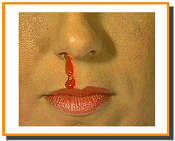 |


- The most common site of epistaxis is the Little's area which is at the anteroinferior quadrant of the septum. Special attention is paid to this region during examination and if found to be the site of orgin, can be cauterized with Silver Nitrate or Trichloro Acetic acid.
- Epistaxis in children can be due to nose picking and this history must be elicited.
- In case of torrential uncontrolled epistaxsis in male children, one must suspect Angiofibroma.
- Unilateral epistaxsis with a foulsmelling discharge in children indicate a longstanding foreign body while that in an elderly patient points to malignancy.
- First aid management of epistaxsis - The patient is asked to squat down, bend forward pinch both nostrils tightly and breathe through the mouth for 5 minutes. This arrests the bleeding in a majority of cases [KOCHER'S METHOD].
- Hypertensive Bleed
The most common cause of spontaneous epistaxsis in elderly is uncontrolled hypertension. A general consensus is that epistaxsis in a hypertensive individual is a prelude to the more deadly Intracereberal hemorrhage. The management of such an episode involves a team work of physicians and ENT surgeons. The physician should bring down the blood pressure considerably though not abruptly and maintain it in a safe range. The ENT surgeon on his part packs the nose with a bland ointment pack (Do not use a sympathomimetic like adrenalin pack as it will worsen the condition). A posterior nasal pack might also be required if the bleeding is not controlled using an anterior pack alone.
- Posterior Nasal Packing
Posterior nasal packing is messy and cumbersome given the anxious state of the patient. An easier alternative is the Foley's catheter. A regular size (no 16) Foleys can be eased into the nostril of the patient and pushed till the tip of the catheter can be seen in the Orophanynx. The bulb is then inflated either with saline or air till the bleeding stops. Gentle traction is applied to the catheter and fixed to the skin with an adhesive plaster. The anterior nasal packing is then done to complete the procedure. This pack is left insitu for 24 - 48 hrs but adequate care must be taken to prevent necrosis of the nasal ala due to traction of the catheter.
|

|
|

